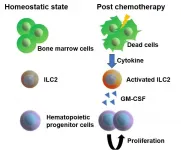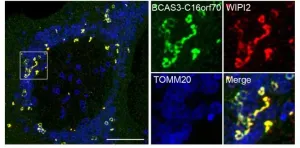(Press-News.org) A new review of existing evidence proposes eight hallmarks of environmental exposures that chart the biological pathways through which pollutants contribute to disease: oxidative stress and inflammation, genomic alterations and mutations, epigenetic alterations, mitochondrial dysfunction, endocrine disruption, altered intercellular communication, altered microbiome communities, and impaired nervous system function.
The study by researchers at Columbia University Mailman School of Public Health, Ludwig Maximilian University, and Hasselt University is published in the journal Cell.
"Every day we learn more about how exposure to pollutants in air, water, soil, and food is harmful to human health," says senior author Andrea Baccarelli, MD, PhD, chair of Environmental Health Sciences at Columbia Mailman School. "Less understood, however, are the specific biological pathways through which these chemicals inflict damage on our bodies. In this paper, we provide a framework to understand why complex mixtures of environmental exposures bring about serious illness even at relatively modest concentrations."
We are continually exposed to a mixture of pollutants, which lead to changes in our bodies in multiple domains, from conception to old age. They govern gene expression, train and shape our immune systems, trigger physiological responses, and determine wellbeing and disease.
The paper summarizes evidence for eight hallmarks of environmental insults:
1. Oxidative stress and inflammation: When antioxidant defenses are depleted, inflammation, cell death, and organ damage occur.
2. Genomic alterations and mutations: An accumulation of DNA errors can trigger cancer and other chronic diseases.
3. Epigenetic alterations: Epigenetic changes alter the synthesis of proteins responsible for childhood development and regular function of the body.
4. Mitochondrial dysfunction: A breakdown in the cellular powerplant may interfere with human development and contribute to chronic disease.
5. Endocrine disruption: Chemicals found in our environment, food, and consumer products disrupt the regulation of hormones and contribute to disease.
6. Altered intercellular communication: Signaling receptors and other means by which cells communicate with each other, including neurotransmission, are affected.
7. Altered microbiome communities: An imbalance in the population of bacteria and other microorganisms in our body can make us susceptible to allergies and infections.
8. Impaired nervous system function. Microscopic particles in air pollution reach the brain through the olfactory nerve, and can interfere with cognition.
Not all environmental exposures are harmful. The researchers note that exposure to nature has been reported to have beneficial impacts on mental health.
These eight hallmarks are by no means comprehensive and do not capture the full complexity of the chemical and physical properties of environmental exposures, including mixtures of exposures over the short and long-term. Further research is needed to understand the complex mechanisms by which exposures affect human biology, and how altered processes interact and contribute to disease or confer health benefits, across the life course.
"We need research to expand our knowledge of disease mechanisms going beyond genetics.
Advances in biomedical technologies and data science will allow us to delineate the complex interplay of environmental insults down to the single-cell level," says Baccarelli. "This knowledge will help us develop ways to prevent and treat illness. With the serious environmental challenges like air pollution and climate change, most of all, we need strong local, national, and inter-governmental policies to ensure healthy environments."
INFORMATION:
The study's corresponding author is Annette Peters, PhD, director of the Institute of Epidemiology at Helmholtz Zentrum München, German Research Center for Environmental Health, and chair of epidemiology, Institute for Medical Information Processing, Biometry and Epidemiology, Ludwig Maximilian University of Munich. Tim S. Nawrot, PhD, Hasselt University, Hasselt, Belgium, is a co-author.
Support for the research was provided by a grant from the European Union's Horizon 2020 research and innovation program (874627), the Flemish Research Fund, Belgium (G048420N), and the National Institute of Environmental Health Sciences (P30009089, ES025225, ES032638).
Patients' electronic health records convey crucial information. The application of natural language processing techniques to these records may be an effective means of extracting information that may improve clinical decision making, clinical documentation and billing, disease prediction and the detection of adverse drug reactions. Adverse drug reactions are a major health problem, resulting in hospital re-admissions and even the death of thousands of patients. An automatic detection system can highlight said reactions in a document, summarise them and automatically report them.
In this context, the Basurto University Hospital and the Galdakao ...
A monoclonal antibody "cocktail" developed at Vanderbilt University Medical Center (VUMC) to neutralize the COVID-19 virus is effective against all known strains, or variants, of the virus, according to a report published in the journal Nature Medicine.
That was one of the findings reported by a multi-institutional team led by researchers at Washington University School of Medicine in St. Louis.
In cell-culture studies, the researchers determined the ability of monoclonal antibodies as well as antibodies isolated from the "convalescent plasma" of previously infected people to neutralize highly transmissible variants of the SARS-CoV-2 virus that have arisen in the United Kingdom, South Africa, Brazil and elsewhere.
In general, most of the monoclonal antibodies that have ...
Can Switzerland, as planned, cut its CO2 emissions to zero by 2050? In a study, researchers at the Paul Scherrer Institute PSI have investigated what measures would be necessary to achieve this reduction and how much it might cost per person.
In August 2019, the Swiss Federal Council decided on an ambitious target to limit climate change: From the year 2050 onward Switzerland should, on balance, discharge no further greenhouse gas emissions. With this commitment, Switzerland meets the internationally agreed goal of limiting global warming to a maximum of 1.5° C compared to the pre-industrial era.
Now a study by the Paul Scherrer Institute, ...
Functioning ecosystems provide the basis for security, basic material needs, health, social interaction and individual liberty. This is how the Millennium Ecosystem Assessment 2005 described it, dividing ecosystem services into the following categories: The provisioning services; goods such as food, water, firewood and timber, the regulating services; pollination, water filtering function of the soil, flood and erosion protection, and the cultural services; recreation, places of inspiration, and education. Many of these services are indirectly and directly linked to the presence of species. For this reason, species conservation is often put forward as a measure for the conservation of vital natural services.
"However, most previous ...
PHILADELPHIA - Intellectual disability puts individuals at higher risk of dying earlier in life than the general population, for a variety of medical and institutional reasons. A new study from Jefferson Health examined how the COVID-19 pandemic has affected this group, which makes up 1-3% of the US population. The study, published today in the New England Journal of Medicine (NEJM) Catalyst, found that intellectual disability was second only to older age as a risk factor for dying from COVID-19.
"The chances of dying from COVID-19 are higher for those with intellectual disability than they are for people with congestive heart failure, kidney disease or lung disease," says lead author Jonathan Gleason, MD, the James D. and Mary Jo Danella ...
Osaka, Japan - Chemotherapy has a damaging effect on hematopoietic stem and progenitor cells (HSPCs) in bone marrow. However, once chemotherapy ends, HSPCs regenerate, a process that has remained unknown--until now. In a new study, researchers from Osaka University have identified the molecular mechanism by which HSPCs recover after injury.
HSPCs reside in the bone marrow and give rise to several types of blood cells, such as red blood cells (which carry oxygen), some white blood cells (which are important for the immune system) and platelets (which are necessary to stop bleeding). Because HSPCs constantly divide to generate new cells, they are particularly sensitive to injury induced by, for example, chemotherapy. ...
Semiconductor materials play an indispensable role in our modern information-oriented society. For reliable performance of semiconductor devices, these materials need to have superior mechanical properties: they must be strong as well as resistant to fracture, despite being rich in nanoscale structures.
Recently, it has become increasingly clear that the optical environment affects the structural strength of semiconductor materials. The effect can be much more significant than expected, especially in light-sensitive semiconductors, and particularly since due to technological constraints ...
Background: Although caregivers of patients with eating disorders usually experience a heavy caregiving burden, the effects of social support on caregivers of patients with eating disorders are unknown. This study aimed to investigate how social support for mothers who are caregivers of patients with an eating disorder improves the mothers' mental status and, consequently, the symptoms and status of the patients.
Methods: Fifty-seven pairs of participants were recruited from four family self-help groups and one university hospital in Japan. Recruitment was conducted from July 2017 to August 2018. Mothers were ...
Autophagy is an intracellular degradation process of cytosolic materials and damaged organelles. Researchers at Ubiquitin Project of TMIMS have been studying the molecular mechanism of mitophagy, the selective autophagy process to eliminate damaged mitochondria. PINK1 (a serine/threonine kinase) and Parkin (a ubiquitin ligating enzyme: E3) work together to ubiquitylate the outer membrane proteins of damaged mitochondria, then ubiquitin chains are recognized as signals for autophagy degradation. Dysfunction of mitophagy causes a decrease in mitochondrial quality with overproduction of ROS, and is linked to neurodegenerative diseases like Parkinson's disease.
In Autophagy machinery, cellular components targeted for degradation are engulfed by phosphatidylinositol-3-phosphate (PI3P)-rich ...
Frequently occurring chronic skin inflammation like in atopic dermatitis (AD or neurodermatitis) and psoriasis have different causes such as genetic predisposition, stress or allergens. These frequently occurring skin diseases are mostly attributed by biomedical scientists to a disturbed immune system, although the noticeable thickening and flaking of the epidermis, which is the outermost layer of skin, also indicates a disruption of the epithelial cells. A team of researchers from the University Clinic for Dermatology and the Clinical Institute for Laboratory Medicine at MedUni Vienna has now been able to identify new molecular ...





